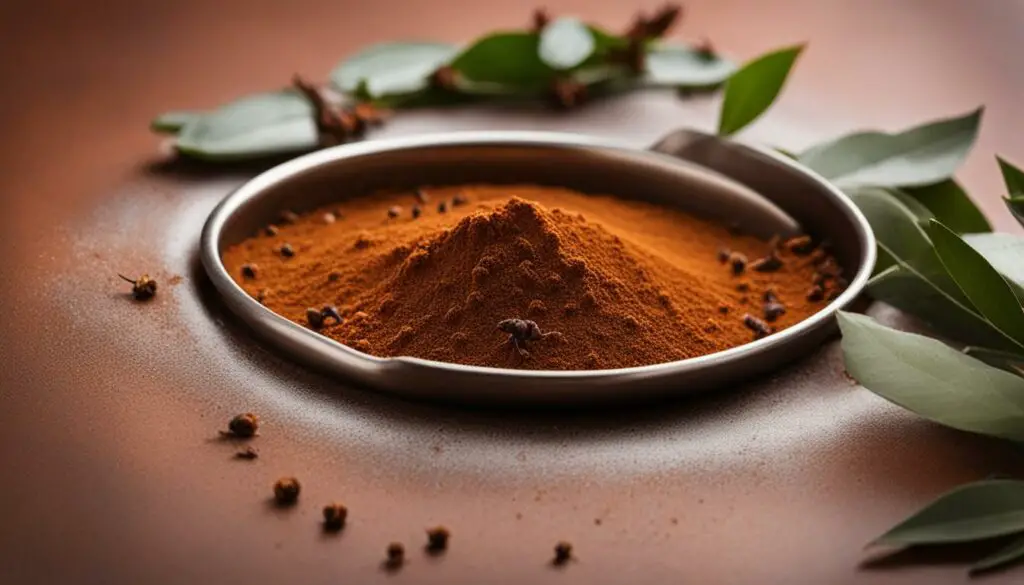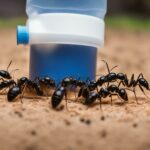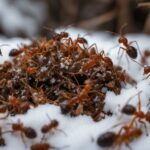As a cat owner, I understand the importance of ensuring that our feline friends have a safe and uninterrupted dining experience. However, pesky ants can often find their way into our cat’s food, causing not only frustration but also potential health risks. In this article, we will dive deeper into the subject of how to keep ants out of cat food and explore effective methods and DIY solutions to protect our cats’ meals.
Key Takeaways:
- Ants can disrupt your cat’s meals and pose potential health risks.
- Understanding ant behavior and what attracts them to cat food is crucial.
- There are various methods and DIY solutions to keep ants away from your cat’s food bowl.
- Natural remedies and ant traps can be effective in repelling ants.
- Using ant-proof cat bowls and maintaining cleanliness in the feeding area can help prevent ant infestations.
Understanding Ant Behavior and Attraction to Cat Food
Ants are fascinating creatures with complex behavior patterns. To effectively keep them away from your cat’s food, it’s important to understand what attracts them in the first place.
Ants are naturally attracted to the smell of food, and cat food with its strong odors can be particularly enticing to them. The high protein content and meat-based ingredients in many cat foods make them even more appealing to ants. These tiny insects are capable of detecting even the faintest aroma of food, and once they find a food source, they leave a pheromone trail that attracts other members of their colony. This is why it’s common to see a line of ants marching towards your cat’s food bowl.
In addition to smell, ants are also attracted to moisture. If your cat’s food bowl is not properly cleaned or if there are spills and crumbs left around, it can create a damp environment that further attracts ants. Keeping the feeding area clean and dry is crucial in preventing ant infestations.

Ant Behavior and Attraction to Cat Food
Understanding ant behavior and their attraction to cat food is essential in finding effective solutions to keep them away. By being aware of their preferences for food smells and moisture, you can take proactive measures to prevent them from accessing your cat’s food and ensure their health and well-being.
Why Keeping Ants Out of Cat Food is Important
Keeping ants out of your cat’s food is of utmost importance for the health and well-being of your furry friend. Allowing ants to access your cat’s food can lead to contamination and potential health issues. Ants can carry bacteria and other pathogens that can be harmful if ingested by your cat. Therefore, it is crucial to prevent ants from contaminating your cat’s food to ensure their safety and well-being.
Ants are skilled at finding food sources and can disrupt your cat’s meals. They are attracted to the smell of cat food, especially if it contains meat or strong odors. Understanding their behavior and attraction to cat food is essential in finding effective solutions to keep them away from your cat’s food bowl.
By repelling ants from your cat’s food, you are taking a proactive approach to safeguarding your pet’s health. Ingesting large numbers of ants can lead to gastrointestinal discomfort and potentially harmful bacterial infections. Prevention is key when it comes to keeping ants out of your cat’s food, as it eliminates the risk of your cat ingesting ants and the potential health consequences that may follow.
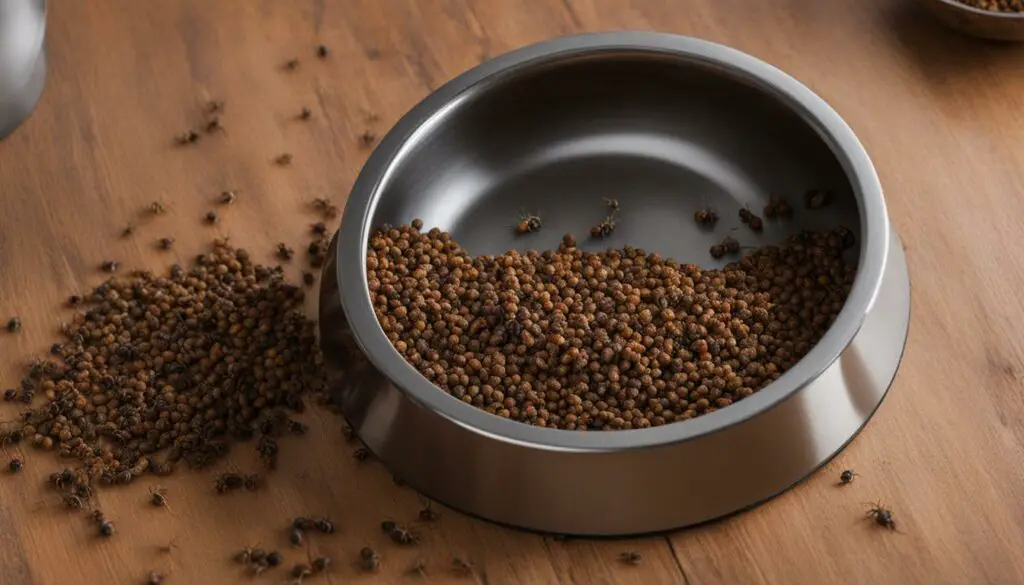
In the next section, we will explore helpful tips and strategies for ant-proofing your cat’s food and keeping those pesky intruders at bay. By implementing these measures, you can ensure that your cat’s meals are pest-free and safe from ant contamination.
Tips for Ant-Proofing Your Cat Food
When it comes to keeping ants away from your cat’s food, there are several effective methods you can utilize. By taking these additional precautions, you can ensure that your feline friend’s meals remain ant-free and safe. Here are some tips to help you ant-proof your cat’s food:
1. Use Pet Food Dispensers
Consider using pet food dispensers that are designed with built-in barriers or moats. These barriers prevent ants from accessing the food, keeping it safe and free from contamination. It’s a simple yet effective solution to keep ants at bay.
2. Keep the Feeding Area Clean
A clean feeding area is essential in deterring ants from invading your cat’s food. Clean up any spilled food or crumbs promptly and wipe down the area regularly. Ants are attracted to food residue and keeping the area clean will make it less appealing to them.
3. Limit Access to Food
If you notice ants are still finding their way to your cat’s food, consider limiting their access. Place the food bowls on elevated surfaces or use a tray with water to create a moat around the bowl. Ants are less likely to cross water barriers, providing an effective deterrent.

4. Change the Location of the Bowls
If ant activity persists, try changing the location of the food bowls. Ants may have established scent trails leading to the current feeding area. By relocating the bowls, you disrupt these trails and make it harder for ants to find the food source.
By implementing these tips, you can effectively ant-proof your cat’s food and ensure their meals remain free from any unwanted pests. Remember to regularly monitor the feeding area for any signs of ants and make adjustments as needed to maintain a pest-free environment for your furry companion.
Natural Remedies to Repel Ants from Cat Food
When it comes to keeping ants away from your cat’s food, natural remedies can be an effective and safe solution. Not only do these natural methods help repel ants, but they also minimize the risk of exposing your furry friend to harsh chemicals.
One natural remedy to repel ants is to make use of ant-repellent plants. Plants such as mint, citrus peels, and bay leaves are known to have strong scents that ants dislike. Placing these plants near your cat’s feeding area or using their leaves as a deterrent can help keep ants at bay.
In addition to plants, there are several household ingredients that can repel ants. Vinegar, lemon juice, and cinnamon are all effective repellents. Spraying mixtures of these ingredients around the feeding area creates a barrier that ants will avoid. You can also use essential oils such as peppermint or lavender, as ants find their strong scents unpleasant.
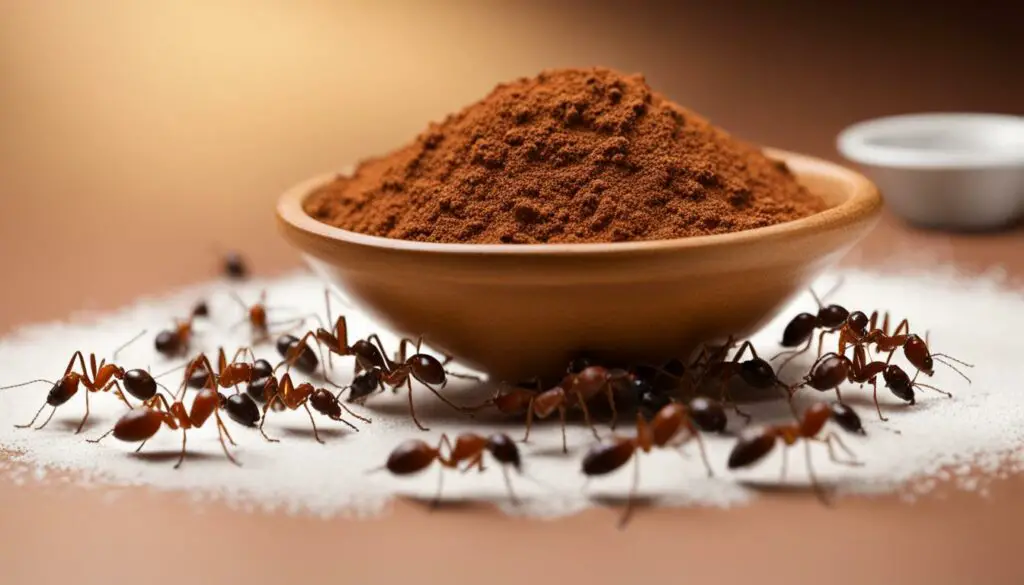
Another natural approach is to create a moat around the cat’s food bowl. This involves placing the food bowl in a larger dish filled with water. Ants cannot swim, so the water acts as a barrier that keeps them away from the food. This method is simple yet effective in deterring ants from reaching your cat’s food.
Summary:
Natural remedies provide a safe and effective way to repel ants from your cat’s food. Using ant-repellent plants, household ingredients like vinegar and lemon juice, and creating a moat around the food bowl can all help keep ants at bay. By implementing these natural solutions, you can ensure your cat’s meals remain ant-free and promote their overall well-being.
Using Ant Traps and Baits for Ant Control
When natural remedies and DIY solutions fail to eliminate ants from your cat’s food, it may be necessary to turn to ant traps and baits for effective ant control. These products are designed to attract ants and eliminate them at the source, preventing further infestation.
Ant traps work by luring ants into a device that contains a sticky substance or a toxic bait. Once the ants enter the trap, they become trapped inside and eventually die. These traps are typically safe for use around pets, but it is important to choose traps specifically labeled as pet-safe to ensure the well-being of your cat.
“Ant traps are an effective way to eliminate ants and prevent them from reaching your cat’s food. They target the ants directly and provide long-lasting control.”
Ant baits, on the other hand, are designed to attract ants and entice them to consume a toxic substance. The ants then carry the bait back to their colony, where it is shared with other ants, eventually leading to the eradication of the entire colony. It is essential to place the bait stations in areas inaccessible to your cat to prevent accidental ingestion.
For effective ant control, it is recommended to consult a professional pest control company. They have the expertise to identify the type of ants infesting your cat’s food and to recommend the appropriate traps or baits for effective eradication. Professional ant control services can also implement preventive measures to ensure long-term ant prevention.
| Ant Traps and Baits | Features |
|---|---|
| Ant Traps | – Lure ants into a sticky substance or toxic bait – Safe for use around pets |
| Ant Baits | – Attract ants with a toxic substance – Ants carry the bait back to their colony – Requires careful placement to prevent ingestion by pets |
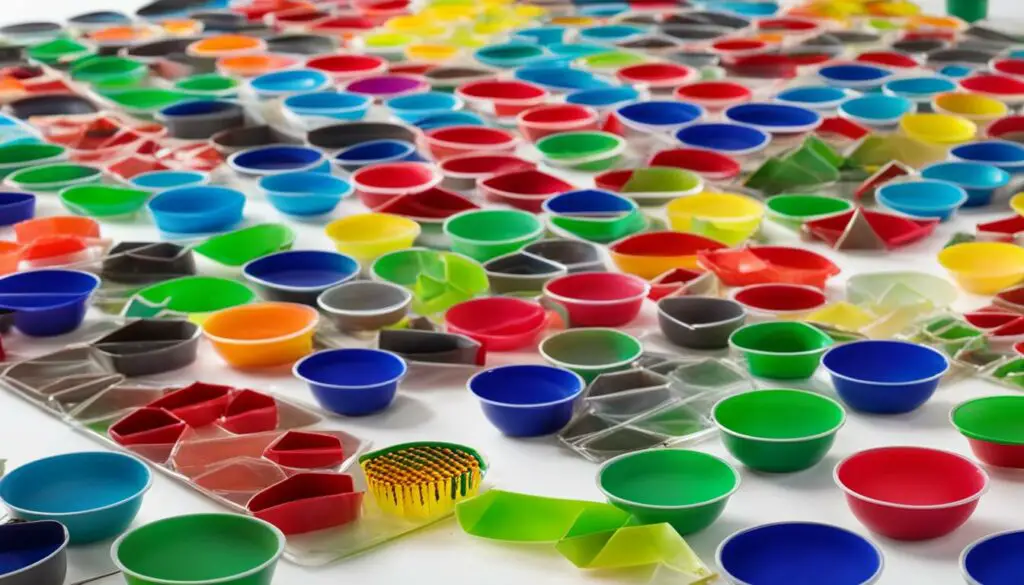
Dealing with Ants in Dry Cat Food
If you’ve discovered ants in your cat’s dry food, it’s important to take immediate action to prevent further contamination. Ants can not only render the food inedible but also introduce harmful bacteria and pathogens. Here are some effective tips to deal with ants in dry cat food:
Keep the food under direct sunlight
Ants are sensitive to heat, so placing the affected dry food container under direct sunlight can deter them. The sunlight will create an inhospitable environment for the ants, forcing them to seek food elsewhere. However, make sure to transfer the food to a new container, as the original one may still contain ant remnants.
Utilize baking powder
Baking powder can act as a natural repellent for ants. Sprinkle a thin layer of baking powder around the affected area or directly on the dry cat food. The baking powder disrupts the ants’ scent trails, making it difficult for them to locate and access the food. Additionally, the powder can also dehydrate the ants, further deterring them from approaching the food.
Remember, if the infestation is severe or persists despite these measures, it’s advisable to discard the contaminated dry cat food and replace it with fresh, ant-free food. Ensuring your cat’s food is free from ants is crucial for their health and well-being.
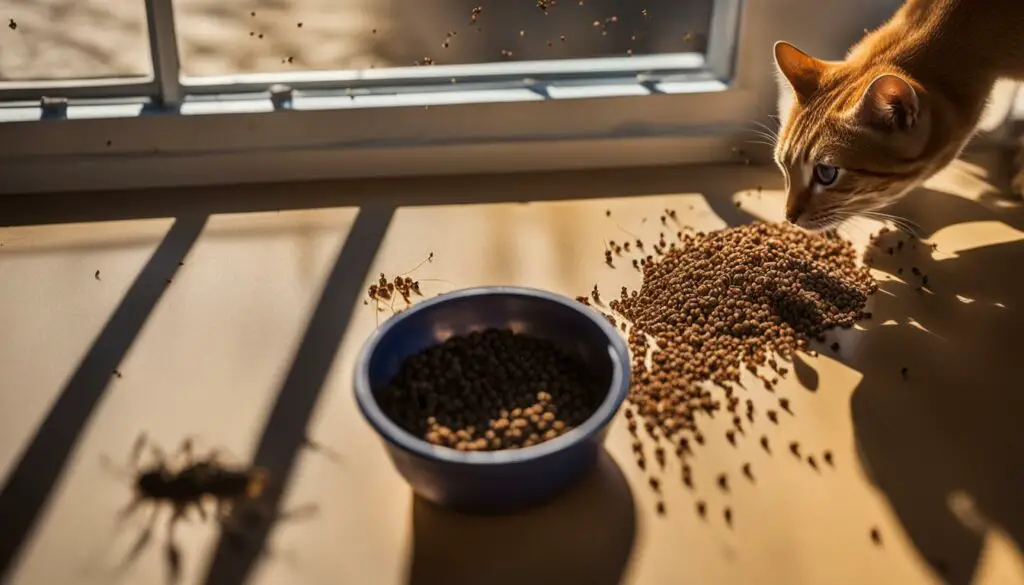
Dealing with Ants in Wet Cat Food
When ants have found their way into your cat’s wet food, it can be a challenging situation to handle. While there are temporary solutions to remove the ants from the food, it is advisable to prioritize your cat’s safety and discard the contaminated food. The ingestion of ants can potentially harm your cat, so taking immediate action is crucial.
If you notice ants in your cat’s wet food, one method you can try is using a hairdryer or blower to blow away the ants from the surface. However, this is not a foolproof solution, as ants may retreat to crevices or corners of the food. It is best to err on the side of caution and dispose of the wet food completely.
To avoid future ant infestations in your cat’s wet food, it is important to store the food properly. Ensure that the food is tightly sealed in airtight containers to prevent ants from accessing it. Additionally, cleaning the feeding area regularly and promptly disposing of any spilled food can help discourage ants from being attracted to the area.
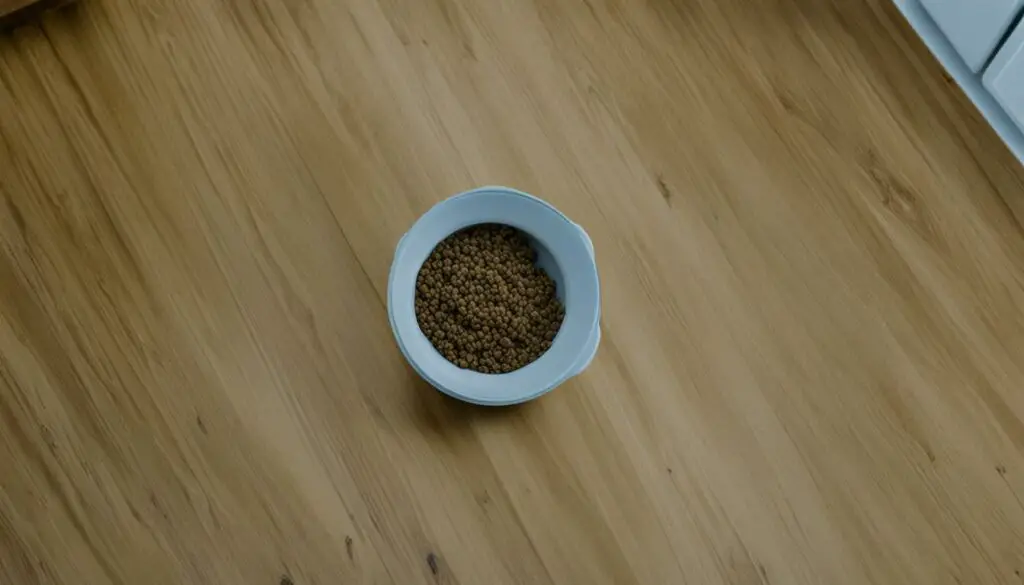
Table: Pros and Cons of Dealing with Ants in Wet Cat Food
| Pros | Cons |
|---|---|
| Drying the wet food with a hairdryer can remove visible ants | Ants may retreat to hidden areas of the food |
| Immediate action to discard the wet food ensures your cat’s safety | It may result in wasting food |
| Proper storage and cleanliness can prevent future ant infestations | Requires consistent maintenance and vigilance |
By being proactive in preventing ants from accessing your cat’s wet food, you can ensure their meals remain safe and free from contamination. Implementing proper storage techniques and maintaining a clean feeding area will help safeguard your cat’s health and well-being.
The Effects of Ants on Cat Health
When ants invade the food of our feline friends, it can have negative consequences for their health. While a few stray ants may not pose a serious risk, ingesting large numbers of ants can lead to gastrointestinal discomfort and potentially harmful bacterial infections. It is crucial to take measures to keep ants away from your cat’s food to ensure their well-being.
Ants can carry bacteria and other pathogens that can be harmful if ingested by your cat. These microorganisms can cause digestive issues, such as vomiting or diarrhea, and in severe cases, can lead to serious illnesses. Additionally, the presence of ants in your cat’s food can also cause stress and anxiety for your pet, leading to a decreased appetite and potential weight loss.
To protect your cat’s health, it is important to prevent ants from accessing their food. By using ant-proof cat bowls, implementing preventative measures, and utilizing natural remedies or professional assistance, you can ensure that your cat’s meals are free from ant contamination and promote their overall well-being.
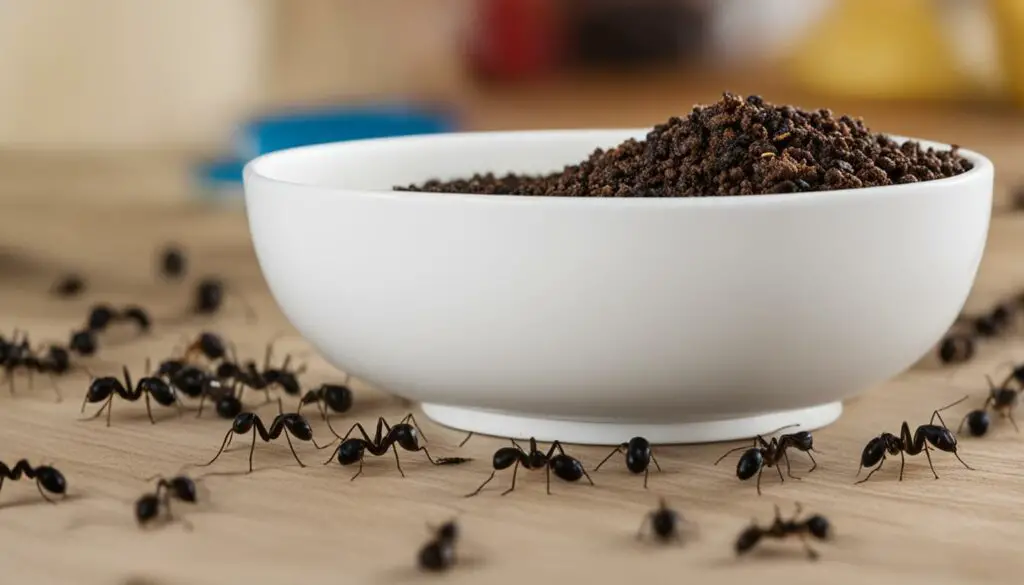
| Effects of Ants on Cat Health | Prevention Measures |
|---|---|
| Ingestion of large numbers of ants can cause gastrointestinal discomfort and potentially harmful bacterial infections. | Use ant-proof cat bowls to keep ants away from the food. |
| Presence of ants in cat food can lead to stress and anxiety, resulting in decreased appetite and potential weight loss. | Implement preventative measures such as keeping the feeding area clean and storing cat food in airtight containers. |
| Ants can carry bacteria and pathogens that can cause digestive issues and serious illnesses in cats. | Utilize natural remedies or seek professional assistance for effective ant control. |
Choosing Ant-Proof Cat Bowls
When it comes to keeping ants away from your cat’s food, choosing ant-proof cat bowls can be a game-changer. These specialized bowls are designed with barriers or moats that prevent ants from accessing the food. By implementing this simple solution, you can ensure that your cat’s meals remain pest-free and uncontaminated.
There are various options available for ant-proof cat bowls, including simple DIY alternatives. One popular method is to place the cat food bowl in a larger dish filled with water. The water acts as a moat, creating a barrier that ants cannot cross. Alternatively, you can use aluminum baking pans placed upside down with the cat food bowl placed on top. The slippery surface of the pan prevents ants from reaching the food.
Another DIY option is to repurpose items you may already have at home. A pot rack, for example, can be used as a platform for the cat food bowl, keeping it elevated and out of reach from ants. Plastic containers with inverted lids can also serve as effective barriers. The key is to create a physical obstacle that ants cannot overcome.
| Advantages of Ant-Proof Cat Bowls | Disadvantages of Ant-Proof Cat Bowls |
|---|---|
|
|
By investing in ant-proof cat bowls, you can effectively keep ants away from your cat’s food and ensure their meals are always safe and enjoyable. Whether you choose a commercial product or opt for a DIY solution, the important thing is to create a barrier that ants cannot breach. With a little creativity and resourcefulness, you can provide your cat with a pest-free dining experience.
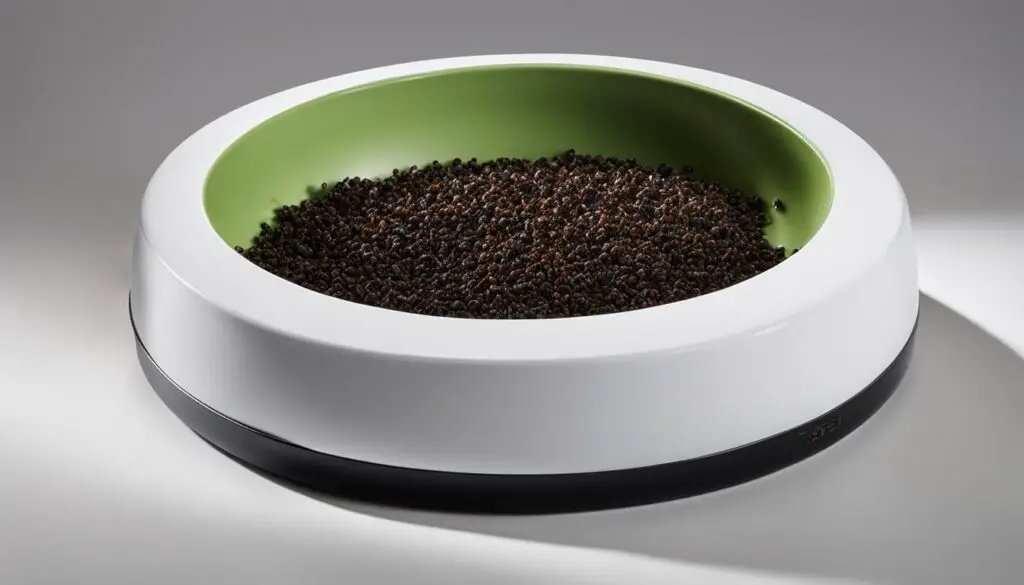
Tips for Keeping Ants Out of Cat Food
When it comes to keeping ants away from your cat’s food, there are several effective tips and strategies that you can employ. By implementing these measures, you can ensure that your furry friend’s meals are free from ant contamination and maintain their health and well-being. Here are some helpful tips:
1. Keep the feeding area clean:
To deter ants from approaching your cat’s food, it is important to keep the feeding area clean and tidy. Regularly wipe down the food bowls, remove any spilled food or crumbs, and ensure that the surrounding area is free from food debris. Ants are attracted to food residue, so maintaining a clean environment can help keep them at bay.
2. Store cat food properly:
Ants can easily find their way into improperly stored cat food. To prevent this, store your cat’s food in airtight containers to seal off any enticing smells that may attract ants. By keeping the food securely sealed, you can minimize the risk of ants infesting it.
3. Utilize natural ant repellents:
There are several natural remedies that can repel ants from your cat’s food area. For instance, spraying a solution of vinegar and water around the feeding area can deter ants due to its strong odor. You can also use essential oils such as peppermint or citronella, as ants dislike these scents. Just be cautious and ensure that these substances are safe for your cat.
By following these tips, you can create an ant-free environment for your cat’s meals. Remember to regularly assess the effectiveness of your ant control measures and make any necessary adjustments to keep those pesky ants at bay.
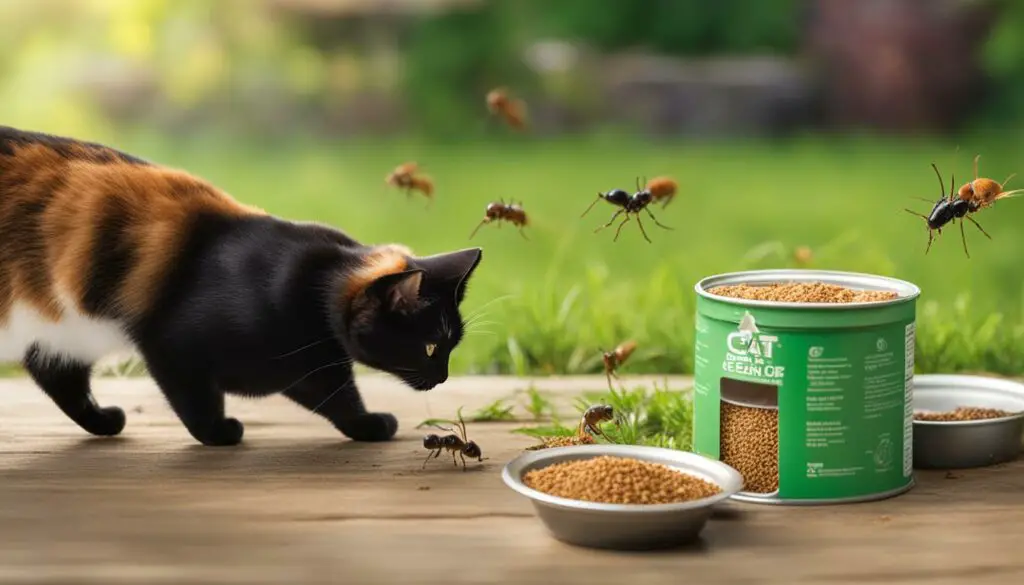
Professional Ant Control and Prevention
When DIY solutions and natural remedies fail to effectively control ant infestations, it may be necessary to seek professional assistance for ant control and prevention. Pest control professionals are trained and equipped to handle ant problems efficiently, ensuring the safety and well-being of your cat.
Professional ant control involves a thorough inspection of your home to identify the source of the infestation. The exterminator will then develop a customized treatment plan tailored to your specific situation. This may include the use of targeted ant baits, sprays, or dusts to eliminate the existing ant population. The professional will also provide recommendations and implement preventive measures to prevent future ant invasions.
It is essential to choose a reputable pest control company that specializes in ant control. Look for companies that are licensed, insured, and have positive reviews from previous customers. Professional ant control may require multiple visits to ensure the complete eradication of ants and long-term prevention.
To further prevent ant infestations in the future, it is important to address any potential entry points for ants, such as gaps in doors, windows, or walls. Regularly inspect and seal these entry points to minimize the risk of ants entering your home. Additionally, keeping your cat’s feeding area clean and free of spills will help deter ants from being attracted to the area.
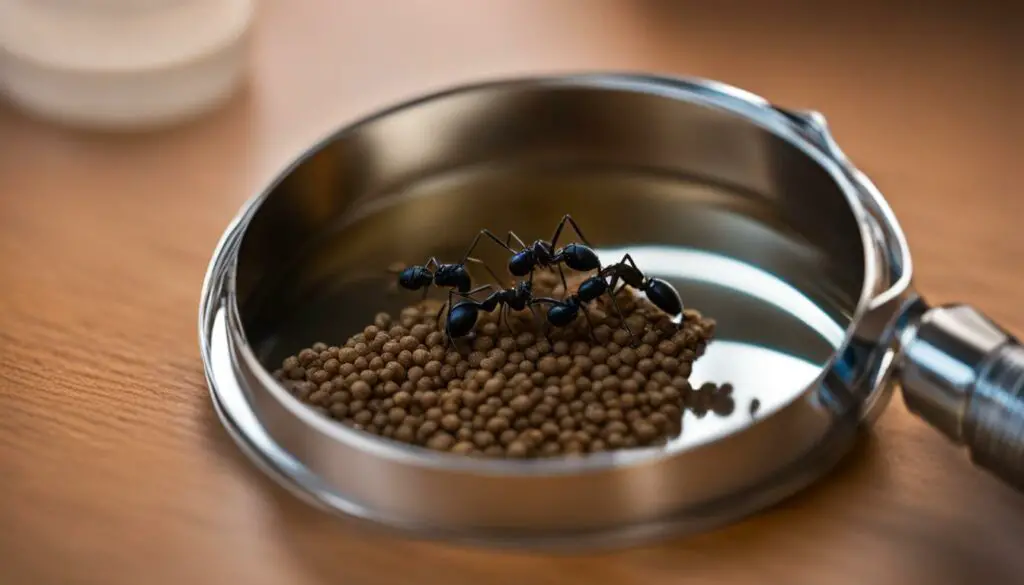
| Benefits of Professional Ant Control | Preventive Measures |
|---|---|
| Effective elimination of ant colonies | Sealing entry points to prevent ants from entering |
| Customized treatment plans tailored to your situation | Maintaining a clean and tidy feeding area for your cat |
| Long-term prevention of ant infestations | Regular inspections and sealing of potential entry points |
| Expert knowledge and use of safe, cat-friendly products | Professional advice on ant prevention strategies |
By enlisting the services of a professional pest control company, you can effectively eliminate ant infestations, safeguard your cat’s food, and maintain a pest-free home. Remember to follow the recommendations provided by the professional to prevent future ant problems and ensure the well-being of your furry friend.
Conclusion
In conclusion, keeping ants out of your cat’s food is crucial for their health and well-being. Ants can contaminate the food with harmful bacteria and pathogens, posing a risk to your cat’s digestive system.
By using various methods and DIY solutions, such as ant-proof cat bowls, natural remedies, and implementing preventive measures, you can effectively repel ants and ensure your cat’s meals remain pest-free. It is also essential to keep the feeding area clean, store cat food properly, and promptly clean up any spills or crumbs to discourage ant infestations.
If DIY solutions do not resolve the ant problem, seeking professional pest control assistance may be necessary. Pest control professionals have the expertise to eliminate ant colonies and implement preventive measures to prevent their return.
Remember, a healthy and safe feeding environment is vital for your cat’s overall well-being. By taking proactive steps to keep ants away from your cat’s food, you can provide them with nutritious and uncontaminated meals.
FAQ
What are the risks of allowing ants to access my cat’s food?
Allowing ants to access your cat’s food can lead to contamination and potential health issues for your cat. Ants can carry bacteria and other pathogens that can be harmful if ingested.
How can I keep ants away from my cat’s food?
There are several effective methods for keeping ants away from your cat’s food, including using pet food dispensers, keeping the feeding area clean, limiting access to food, changing the location of the bowls, using physical barriers like sticky tape or petroleum jelly, and using natural repellents like ant-repellent plants, vinegar, lemon juice, cinnamon, or essential oils.
What should I do if natural remedies don’t work?
If natural remedies are not effective, using ant traps or baits can help control ant populations. It is important to ensure that these products are safe for your cat and placed in areas inaccessible to them. Consulting a professional pest control company for safe and effective ant control is also recommended.
How can I deal with ants in dry cat food?
If ants have invaded your dry cat food, you can try placing the food under direct sunlight or using baking powder to repel and remove ants. However, if the infestation is severe, it is best to discard the contaminated food and start with fresh, ant-free food.
What should I do if ants have contaminated wet cat food?
Dealing with ants in wet cat food is more challenging. You can try using a hairdryer or blower to blow away the ants, but it is advisable to discard the food to ensure your cat’s safety and prevent ingestion of any ants.
What are the effects of ants on my cat’s health?
While a few ants may not pose a serious health risk to your cat, ingesting large numbers of ants can lead to gastrointestinal discomfort and potentially harmful bacterial infections. Keeping ants away from your cat’s food is crucial for their well-being.
How can I choose ant-proof cat bowls?
Using ant-proof cat bowls is an effective way to prevent ants from accessing your cat’s food. There are various DIY options available, including using water, aluminum baking pans, pot racks, or plastic containers.
What other tips can help me keep ants out of my cat’s food?
In addition to using ant-proof bowls, it is important to keep the feeding area clean and tidy, store cat food in airtight containers, and use natural ant repellents or ant baits. Seeking professional pest control assistance may be necessary if the infestation persists or becomes severe.
How can I seek professional ant control and prevention?
If the ant infestation becomes severe or persists despite DIY solutions, it may be necessary to seek professional pest control assistance. Pest control professionals have the knowledge and tools to effectively eliminate ant colonies and implement preventive measures to keep them from returning.

